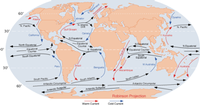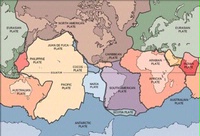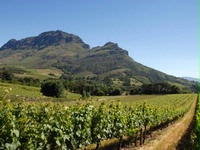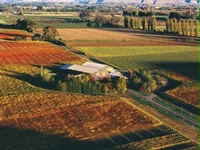Although most of Earth’s landmass, and thus its vineyard land, is in the Northern Hemisphere, there is much of interest to wine lovers in the Southern Hemisphere. In the last three decades, wine growing areas in Chile, Argentina, Australia, New Zealand and South Africa have all demonstrated great potential for fine wine production. Most of these now commonly seen wines were rarely available at all in the US market of the early 1980’s. Their aggregate rise in consumer recognition has transformed the international wine market.

Global Ocean Currents
The best vineyard sites on these southerly continents share the same climatic conditions with the best areas in the Northern Hemisphere. The areas with a Mediterranean climate, marked by warm, dry conditions during the ripening season, are most hospitable to quality wine grape production. Three similar cold oceanic currents influence the major winegrowing regions of the Southern Hemisphere. The Peru current off South America, the Benguela Current off South Africa and West Australia current all flow near to the shore and drain the eastward-moving clouds of their moisture before they make landfall. The result is the dry harvesting conditions necessary for quality wine production. Even so, there are a multitude of geographic factors that influence the viticultural and vinification decisions made in these areas.
In a geologic sense, there are similarities and differences among the Southern Hemisphere regions. The planet beneath us is not as stable as we tend to think. Driven by convective heat beneath the surface, continents are constantly moving on a variety of tectonic plates. A look at the Plate Boundary map reveals that the South American Plate is overriding the oceanic Nazca Plate, which is being pushed beneath it. The result is pressure and violent volcanic action that has caused the uplift of the Andes Mountains and the Coast Ranges. Similar to the west coast of North America, the Coast Range of Chile creates a rain shadow effect that dries out the air over Chile’s broad Central Valley. As these already dried air masses push high over the Andes, they drop nearly all of their moisture in the high elevations and make the vineyards of Argentina’s Mendoza a near desert environment. Fortunately for wine lovers, the moisture wrung out of the clouds is available as irrigation water from the snowmelt of the high Andes.

Tectonic Plates of the Earth
The tectonic plate margins of Australia and Africa, however, are far from the shores of the landmasses. There have not been any recent mountain building episodes on those continents, and the rocks exposed are quite old. South African and Australian vineyards are sited on some of the oldest rocks in the wine world. The eastern edge of the Australian plate lies some 1300 miles from the mainland, where the Australian Plate bumps into the Pacific Plate. Here, at the plate convergence, are the islands of New Zealand. The South Island of New Zealand is literally being ripped apart as the west side moves northward relative to the east side of the island. Evidence of the movement on the leading edges of both the Australian and South American Plates is shown in the strong earthquakes that have occurred in the last decade.
Let’s review what has happened in just one generation as the South has risen in the wine world:
SOUTH AMERICA
Long known for their good, inexpensive whites and reds, the producers of Chile, Argentina, Uruguay and Brazil are offering better and better products that are still among the world’s best values. Chile is best known for red wines of Cabernet Sauvignon, Merlot, and “newly-discovered” Carmenère -- a grape that came from the Bordeaux region of France 160 years ago before the phylloxera devastated the European vineyards. In Chile, protected by geography, the vines remain ungrafted. Thus, while the Carmenère was never replanted in Bordeaux, it continued to thrive in the Chilean vineyards where it was misidentified as Merlot. Now, it is becoming Chile’s distinctive addition to the world’s wine market. White wine grapes like Sauvignon Blanc and Chardonnay and red grapes like Pinot Noir can thrive in those areas affected by cooler marine air. The Casablanca, Leyda and San Antonio Valleys, west of Santiago, show great promise for these cool-climate varieties.
Over the Andes in Argentina’s Mendoza region, the vine thrives in a different climate. The soils here are well-drained and there is an ample supply of irrigation water from the Andes. An area as large as Mendoza is not uniform and, as producers have identified Mendoza’s best microclimates -- generally those at higher and cooler elevations – the resultant wines have increased dramatically in quality. There are also interesting Argentine wines produced in Salta and La Rioja to the north and Rio Negro and Patagonia to the south. Unlike Chile, which was planted largely to Bordeaux varieties, Argentina’s vineyards were set with Sangiovese, Bonarda, Syrah, Tempranillo and Torrontés as well as the Bordelais Cabernet, Merlot and Malbec types. The result is a more varied vinous output that still offers remarkable value. The Malbec, though, does especially well in Argentina and red wine lovers enjoy exploring the nuances of the grape rendered in the Argentine style.

Stellenbosch, South Africa
SOUTH AFRICA
The climate of South Africa tends to be hot unless there is a moderating element, whether it be altitude, shade from the spectacular mountains, or cool maritime air. The combined influence of the Atlantic and Indian Oceans have a great effect on the weather patterns and storm conditions of the Cape.
Areas like Paarl and Stellenbosch have strong cooling influences from the marine air and are South Africa’s most famous growing areas. Many of the wines offered in the United States have the broader appellations of “Coastal Region” and “Western Cape.” These geographic designations encompass Paarl, Stellenbosch and neighboring regions. There are exciting new wines coming from new coastal areas like Elgin, Groenekloof and Walker Bay that will merit watching in years to come. A new wave of producers is seeking out the treasure to be found in old bush-vine Chenin Blanc and Semillon vineyard sites, particularly in Swartland, a broad region stretching north from Cape Town. Some of the best South African wines are now drawn from these venerable vines.
AUSTRALIA
The Australian wine industry rose from virtually nothing in 1980 into a worldwide marketing powerhouse. The downside of becoming known as a source of everyday, inexpensive wines is that consumers are unaware of the best the continent has to offer. As elsewhere, Australia’s truly fine wines are made where there is a cooling maritime influence on the vineyards. Nearly all of Australia’s wine production comes from the states of South Australia, New South Wales and Victoria (the “Southeastern Australia” designation seen on most bottlings). There is growing, but still small, production in Western Australia and Tasmania.
Once you move beyond the simple wines, there is great variety to be found in Australia. In addition to the powerful Shiraz reds of Barossa and McLaren Vale, there are vibrant Rieslings from the Clare Valley and Eden Valley. Well-structured Cabernet Sauvignons and blends abound in Coonawarra and Western Australia’s Margaret River. The state of Victoria is replete with small producing areas. One can find powerful wines from the Goulburn Valley, Pyrenees, Bendigo and Heathcote as well as cooler climate varieties from the Yarra Valley, Mornington Peninsula and Geelong. New South Wales is home to the famous Hunter Valley, as well as the smaller Cowra and Mudgee.

Hawke’s Bay, New Zealand
NEW ZEALAND
Some 1300 miles from the Australian mainland lies New Zealand. Because of the convergence of the Australian and Pacific Plates, the Southern Alps have been pushed up to elevations of 12,000 feet. This creates a dramatic rain shadow effect the dries out the air over the South Island vineyards. Thirty years ago, the country’s wines were limited and unknown. Now, New Zealand has transformed the international wine scene with its distinctively-styled Sauvignon Blancs. The area of Marlborough on New Zealand’s South Island has become synonymous with fine Sauvignon. Cabernet Sauvignon and Merlot blends from Hawke’s Bay on the North Island can be rich and nearly chocolatey in intensity. The South Island area of Central Otago is gaining a reputation for quality Pinot Noir as well. We can look forward to some exciting wines in years to come.
So much has happened in such a short time, it’s hard to grasp the enormity of the changes. Those who studied wine before the explosion in production and availability of Southern Hemisphere products can only applaud the impact they have made. Wine today is overall better in quality and less expensive than three decades ago, thanks in large part to the effort and innovation coming from the South.